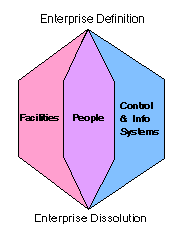PERA Control and Information Architecture
 |
PERA defines the Control and Information Architecture as one of three basic components of any enterprise (the other 2 are the Production Facilites, and the People/Organization). In the PERA Framework, it is usually depicted on the right, although it also has an interface with the "Facilities" of the enterprise, so the diagram might actually be better represented if it were "wrapped around" into a sphere.
|
Unlike the Facility Architecture, and the Human and Organizational Architecture, it has been necessary to develop a number of new diagrams
to represent the Control and Information Systems Architecture and associated networks. These new diagrams begin with the Control and Information Architecture Diagram (CIAD), and progress through increasing levels of detail as the enterprise develops.
CIAD DIAGRAM
Since an adequate diagrams for this purpose was not available, PERA standardized a Control and Information Architecture Diagram (CIAD). Like a PFD, the CIAD is a simplified "block diagram".
The Control and Information Architecture Diagram or (CIAD) is a "simplified block diagram" that shows the information processing nodes (computer systems) and communications (networks) which comprise the Control and Information Systems of the Enterprise. CIADs are similar to the "Process Flow Diagrams" (PFDs) used in process industries, or Mechanical Flow Diagrams (MFDs) used in discrete manufacturing. While the PFD or MFD shows major material flows and processing equipment and storage, the CIAD shows major information flows, information processing, and data storage.
Like the PFD, the CIAD is developed during the Conceptual Engineering Phase. Depending on the complexity and the state of definition of the enterprise, the CIAD may be presented at various levels of detail ranging from very "high level" (e.g. a half page representation of a whole enterprise) to a much more detailed version showing each server farm and block of users.
Depending on the complexity and the state of definition of the enterprise, the CIAD may be presented at various levels of detail ranging from very "high level" (e.g. a half page representation of a whole enterprise) to a much more detailed version showing each server farm and block of users.

CIND DIAGRAM
As the Enterprise design proceeds, the Control and Information Network Diagram (CIND) is developed starting with information on the CIAD. The CIND parallels the development of the P&ID from the PFD. The CIND document is at a "higher level" than the P&ID in the Control and Information Architecture, and "completes" the Control and Information System information presented on the P&ID. The CIND is developed during the "Preliminary Engineering" phase, at the same time that the P&ID is being developed.
Control and Information Network Diagram or (CIND) is a schematic representation of the information processing nodes (computer systems) and communications (networks) which comprise the Control and Information Systems of the Enterprise. CINDs shows backup computing systems and networks, major information flows (rather than just data highways) and may be used to show hazardous plant areas or systems and networks requiring higher cybersecurity protection levels (SL1 to SL4).

The rules for content and presentation of information on the CIAD and CIND diagrams are explained in more detail in "
What are CIAD and CIND Diagrams".
From the Preliminary Engineering Phase onward (when the CIND is developed), a clear distinction is made between diagrams relating to either the physical or logical representations of the Enterprise Control and Information System.
- PHYSICAL Network Diagrams (primarily represent physical networks at increasing levels of detail, ultimately to wiring diagrams.
- LOGICAL Entitiy Relationship Diagrams (primarily representing data structures and program dataflows.
Other Logical Diagrams developed beginning during Preliminary Engineering include Sequence Control Flow Charts (to convey the continuous regularory loops), descrete control logic (interlocks), and sequence control logic (sequence of operations, both manual and automatic). There are a large number of physical arrangement diagrams produced during the Detail Engineering Phase to develop the next level of detail from the CIND. These include but are not limited to:
- Network Diagrams
- Termination Diagrams
- Computer Configuration Drawings
- Continuous Control Logic Diagrams (e.g. SAMA)
- Discrete Logic Diagrams (e.g. Ladder Diagrams)
- Loop Diagrams (wiring diagrams for troubleshooting)
For more discussion of the concept of Control and Information Architectures see "What is
an Information Architecture" in the Frequently Asked Questions section.
We welcome your Comments and Suggestions
Back to PERA Home Page


